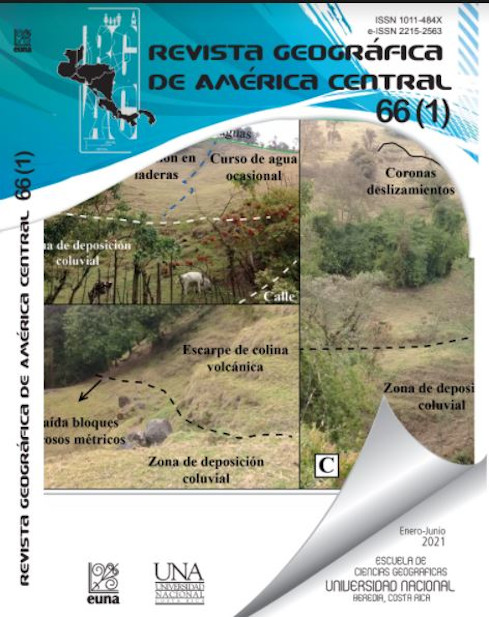Características espectrales del arroz (Oryza sativa L.) bajo condiciones de acamado por paja rugosa (Ischaemum rugosum Salisb.)
DOI:
https://doi.org/10.15359/rgac.66-1.15Palabras clave:
Arroz, Agricultura, Malezas, Sensores remotos, Estado PortuguesaResumen
En Venezuela y el mundo, el arroz es uno de los principales cereales que cubre los requerimientos calóricos del ser humano. La productividad de este cultivo es afectada significativamente por las malezas, dentro de las que destaca la paja rugosa (Ischaemum rugosum Salisb.) por su capacidad de modificar la geometría del dosel, condición desventajosa llamada acamado. Esta modificación de la arquitectura de la planta es analizada y comparada con una plantación sana; a través del comportamiento espectral captado por las imágenes Sentinel 2A. Bajo condiciones de acamado la reflectancia de la plantación de arroz aumenta significativamente en la banda rojo (B4), mientras decrece en las del infrarrojo cercano; efecto que se detecta al inicio de la floración, aproximadamente a los 88 días después de la siembra. El uso de índices de vegetación (VIs), particularmente RVI y NDVI, permitieron diferenciar las plantaciones de arroz sanas y las afectadas por el acamado. Las bandas espectrales que más aportaron a la discriminación de las áreas afectadas son la B4 de la región del visible y la B11 y B12 de la región del infrarrojo medio.
Referencias
Álvarez, R., Torres, O., Reyes, E. y O. Moreno. (2004). El cultivo del arroz en Venezuela. Instituto Nacional de Investigaciones Agrícolas (INIA). Venezuela, pp. 59-70.
Awan, T., Chauchan, B. & P. Cruz. (2014). Physiological and Morphological Responses of Ischaemum rugosum Salisb. (Wrinkled Grass) to Different Nitrogen Rates and Rice Seeding Rates. En: PLoS One, Vol 9 (6).
Bridhikitti, A. & Overcamp, T. (2012). Estimation of Southeast Asian rice paddy areas with different ecosystems from moderate-resolution satellite imagery. En: Agriculture, Ecosystem and Environment, (146), 113 – 120.
Cásares, M. (2012). Diagnóstico sobre la situación del manejo de malezas y la resistencia a herbicidas en el cultivo de arroz en Venezuela. Trabajo de ascenso. Facultad de Agronomía. Universidad Central de Venezuela. Maracay, p.146.
Chauchan, B. (2012). Weed management in direct-seeded rice systems. Los Baños (Philippines): International Rice Research Institute (IRRI), p. 20.
Chauchan, B.S & D.E. Johnson. (2011). Row spacing and weed control timing affect yield of aerobic rice. Field Crops Research 121, pp. 226-231.
Chavez, P.S. (1996). Image-based atmospheric corrections. Revisited and improved. En: Photogrammetric Engineering and Remote Sensing, 62 (9), pp. 1025-1036.
FAO. (2004). El arroz y la nutrición humana. Año internacional del arroz. Roma, Italia. Recuperado: http://www.fao.org/rice2004/es/f-sheet/hoja3.pdf
Ferrero, A & A. Tinarelli. (2008). Chapter 1: Rice Cultivation in the E.U. Ecological. En: Conditions and Agronomical Practices. Pesticide Risk Assessment in Rice Paddies: Theory and Practice. Editorial Elsevier B.V., p. 24.
Guan, X.; Huang, C.; Liu, G.; Meng, X. & Q. Liu. (2016). Mapping Rice Cropping Systems in Vietnam Using an NDVI-Based Time-Series Similarity Measurement Based on DTW Distance. Remote Sensing. Vol. (8), 19, pp. 1-25. http://doi:10.3390/rs8010019
Guillén, C. & Dávila, M. (2017). Guía teórica de Teledetección agrícola. Inventario de cultivos agrícolas. Diplomado en Teledetección y Sistemas de Información Geográfica aplicado a la Agricultura.
Guillén C., Dávila M., Mogollón A., Boscán K. (2019). Monitoreo de la producción de caña de azúcar mediante herramientas de SIG y Teledetección, años 2016-2017, Mérida, Venezuela. En: Revista Geográfica de América Central, 63 (2). Costa Rica., pp. 215 – 236. http://dx.doi.org/10.15359/rgac.63-2.9
Hernández, R. (2017). Metodología para discriminación de malezas basada en la respuesta espectral de la vegetación. Trabajo de investigación presentado como requisito para optar al título de Magister en Geomática. Universidad Nacional de Colombia. Bogotá, Colombia.
Instituto Geográfico Venezolano Simón Bolívar (IGVSM). (2014). Geoportal Nacional Simón Bolívar. Venezuela. Recuperado: http://www.igvsb.gob.ve/
IRRI, (1993). 1993 – 1995 IRRI Rice Almanac. Manila: International Rice Research Institute.
Jiang, Z., Huete, A., Li, Jing. & J. Qi. (2007). Interpretation of the modified soil-adjusted vegetation index isolines in red-NIR reflectance space. Journal of Applied Remote Sensing 1(1):013503. https://doi:10.1117/1.2709702
Johnson, D.E.; M.C.S. Wopereis.; D. Mbodi.; S. Diallo.; S. Power & S.M. Haefele. (2004). Timing of weed management and yield losses due to weeds in irrigated rice in the Sahel. Field Crop Research 85, pp. 31–42.
Khush, G. (2005). What it will take to feed 5 billion rice consumers in 2030. Plant molecular Biology, (59), pp. 1-6.
Knipling, E. (1970). Physical and physiological basis for the reflectance of visible and near-infrared radiation from vegetation. Remote sensing of environment. Vol. (1) 3, pp. 155-159. https://doi.org/10.1016/S0034-4257(70)80021-9
Lubigan, R.T. & K. Moody. (1990). Ischaemum rugosum- some aspects of growth, competitiveness, and control. International Research Rice Institute. Los Baños, Philippines, p. 29.
Mosleh, M.; Hassan, Q. & E. Chowdhury. (2015). Application of Remote Sensors in Mapping Area and Forecasting Its Production: A Review. Sensors. Vol. (15), pp. 769-791. http://doi:10.3390/s150100769
Nguyen D., & Wagner W. (2017). European Rice Cropland Mapping with Sentinel-1 Data: The Mediterranean Region Case Study. Water (9), p. 392. http://Doi:10.3390/w9060392
Nuarsa, I.; Fumihiko N. & H. Chiharu. (2011). Spectral Characteristics and Mapping of Rice Plants Using Multi-Temporal Landsat Data. Journal of Agricultural Science. Vol (3). N° 1, pp. 54-67. http://Doi:10.5539/jas.v3n1p54
Santiago, O. (2006). Teledetección fundamental. 3ra Edición. Escuela técnica superior de ingenieros en topografía, geodesia y cartografía departamento de ingeniería topográfica y cartografía. Universidad Politécnica –Madrid
Ortega, C. (2015). Respuesta espectral en el cultivo de Arroz (Oryza sativa L.) en dos fases fenológicas durante el período invernal 2014. (Trabajo especial de grado. Facultad de Ciencias Agrícolas. Universidad Central del Ecuador). Quito, Ecuador.
Ortiz, A.; Blanco S.; Arana G.; López L.; Torres S.; Quintana Y.; Pérez P.; Zambrano C. & A. Fischer. (2013). Estado actual de la resistencia de Ischaemum rugosum Salisb. Al herbicida bispiribac-sodio en Venezuela. Bioagro 25(2), pp.79-89.
Paredes, M. & Becerra, V. (2015). Producción de Arroz: Buenas prácticas agrícolas (BPA). Boletín INIA N° 36. Instituto de Investigaciones Agropecuarias. Ministerio de Agricultura. Chile.
Paruelo, J. M. (2008). La caracterización funcional de ecosistemas mediante sensores remotos. En: Ecosistemas, 17 (3), pp. 4-22.
QGIS Development Team. Version 2.18.14. (2009). Quantum GIS Geographic Information System, Open Source Geospatial Foundation. Recuperado de: http://qgis.osgeo.org
Qin, Z & Zhang, M. (2005). Detection of rice sheath blight for in season disease management using multispectral remote sensing. International Journal of Applied Earth Observation and Geoinformation (7), pp. 115 – 128.
Richardson, A. J. & Wiegand, C. L. (1977). Distinguishing Vegetation from Soil Background Information. Photogrammetric engineering and remote sensing. Vol (43), 12, pp. 1551-1542.
Rondeaux, G., M. Steven, & F. Bare. (1996). Optimization of soil-adjusted vegetation indices. Remote Sensing and Environment, 55, pp. 95-107.
Rouse, J. W. Jr., Haas, R. H., Deering, D. W., Schell, J. A. and Harlan, J. C. (1974). Monitoring the Vernal Advancement and Retrogradation (Green Wave Effect) of Natural Vegetation 371Greenbelt, MD NASA/GSFC Type III Final Report. [Google Scholar]
Thenkabail, P.; Ward, A. Lyon, J. & C. Merry. (1994). Thematic mapper vegetation indices for determination soybean and corn growth parameter. En: Photogrammetric Engineering and Remote Sensing, Vol (60), pp. 437-442.
Torres, S. & Ortiz, A. (2017). Mecanismos de resistencia de Paja Rugosa (Ischaemum rugosum Salisb.) al herbicida Bispiribac-Sodio en el cultivo de arroz. En: Bioagro 29 (2), pp. 95-104.
Tucker, C. (1979). Red and photographic infrared linear combination for monitoring vegetation. Remote Sensing of Environment 8, pp. 127-150.
Viollier, M., Belsher, T., & L., Loubersac. (1985). Signatures spectrales des objets du littoral. Proceedings of the 3rd International Colloquium Spectral Signatures of Objects in Remote Sensing, SP-247 (Les Arcs: ESA), pp. 253–256.
Yang, C., & Chen, C. (2001). Spectral characteristic of rice plants infested by Brown planthopper. Proceeding of the national Science Council, (25), pp. 180 – 186.
Xiao, X., Boles, S., Liu, J.; Zhuang, D.; Frolking, S.; Li, C.; Salas, W. & B. Moore. (2005). Mapping paddy rice agriculture in Southern China using multi-temporal MODIS images. En: Remote Sensing of Environment. Vol (95), pp. 480 – 492. http://doi:10.1016/j.rse.2004.12.009
Publicado
Cómo citar
Número
Sección
Licencia
Política propuesta para Revistas que ofrecen Acceso Abierto
Los autores que publican en esta revista están de acuerdo con los siguientes términos:
a. Los autores conservan los derechos de autor y garantizan a la revista el derecho de ser la primera publicación del trabajo, bajo la Licencia https://creativecommons.org/licenses/by-nc-sa/4.0/deed.es, que permite a otros compartir con un reconocimiento de la autoría del trabajo y la publicación inicial en esta revista.
b. Los autores pueden establecer por separado acuerdos adicionales para la distribución no exclusiva de la versión de la obra publicada en la revista (por ejemplo, situarlo en un repositorio institucional o publicarlo en un libro), con un reconocimiento de su publicación inicial en esta revista. Esos acuerdos adicionales deben respetar los términos de la licencia: es decir: no involucrar fines de lucro y compartir con la misma licencia.
c. Se anima a los autores a archivar el post-print o versión de editor/PDF en repositorios de acceso abierto.







 REVGEO se encuentra bajo la licencia https://creativecommons.org/licenses/by-nc-sa/4.0/deed.es
REVGEO se encuentra bajo la licencia https://creativecommons.org/licenses/by-nc-sa/4.0/deed.es
.svg_4.png)

_(1).png)
_(1)_(1)_(1)_1.png)
(2)(1)(1)(1).png)
